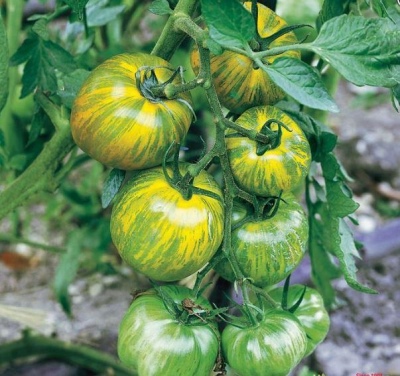
- Authors: Y.D. Tarasov (Euro-Seeds LLC)
- Year of approval: 2018
- Category: grade
- Growth type: indeterminate
- Appointment: fresh consumption, for whole fruit preservation
- Ripening period: early
- Ripening time, days: 85-95
- Growing conditions: for open ground, for film greenhouses
- Bush size: semi-high
- Bush height, cm: 100-150
Tomato A green zebra may well become a regular guest in many vegetable gardens. But in order to get a good result, it is not enough to rely on standard methods - you need to pay attention to the subtleties of handling directly with this variety. It is in them that you should understand in the first place.
Breeding history
The Green Zebra tomato itself was created at Euro-Seeds LLC. Its leading developer was the breeder Yu. D. Tarasov. The official permission to grow the crop was given in 2018.
Description of the variety
The green zebra is a quality indeterminate hybrid. This means, among other things, that the excessive height of the bushes, which is so annoying to many farmers, will be eliminated. They can only grow up to 1-1.5 m. Plants of this variety are spreading and powerful. They are characterized by elongated dark green foliage.
The main qualities of the fruit
Unlike the leaves, the berries of such a plant are light green in color. But this happens only at the very beginning of their development. Mature specimens turn green, interspersed with yellowish stripes. In some cases, reddening of such yellow stripes is noted. There is nothing wrong with that - this is a variant of the norm.
The mass of tomatoes will be from 80 to 120 g. Round shape is typical for them. The ribbing, if pronounced, is relatively weak. Tomatoes are formed on inflorescences of a simple type. They are characterized by an articulated stalk - but this is almost a universal feature of tomatoes in general.
Taste characteristics
The green zebra is sweet - this is even emphasized in the official description. But at the same time, it also contains well-noticeable tart notes. Taken together, this forms an ensemble of flavors attractive to almost any consumer.
Ripening and fruiting
The green zebra is a nice early tomato. Between the appearance of individual timid shoots and the readiness of the crop, it usually takes from 85 to 95 days. Fruit picking usually begins on 15 July. The harvest season ends on average on September 10th. But in some years, these terms may be shifted.
Yield
Tomato Green Zebra belongs to the productive group. This means that the number of berries is not a record, but quite worthy. More precisely, it will be 6.2 kg per 1 m2.
The timing of planting seedlings and planting in the ground
The usual time for planting seeds in containers falls in the last decade of March. If such a schedule is observed, the readiness for transplanting into open ground occurs in the first third of June. However, sometimes, due to objective reasons, it is not possible to keep the sowing time. And the development of seedlings is sometimes exposed to outside influences, unpredictable in advance. Therefore, you will have to carefully monitor the situation and, as necessary, adjust the approach.

Growing tomato seedlings is an extremely important process, because it largely depends on whether the gardener will be able to harvest at all. All aspects must be taken into account, from seedbed preparation to planting in the ground.
Landing scheme
Experts recommend planting such a culture according to the 600x400 mm rule. The permissible density of placement does not exceed 2 or 3 bushes per 1 sq. m. When choosing between these numbers, you need to look at the priority.It can consist both in ease of care and in the absolute size of the harvest.

Growing and care
Already traditional for many varieties, the indication is the need to pinch and form a Green Zebra. Watering the bushes should be moderate. It is best to do this 3 times a week in small portions. Seeds are recommended to be discarded before planting using a saline solution. Protection against late blight is provided by the drug "Ordan".
When watering, it is recommended to add Fitosporin. It is a relatively safe and effective drug. Natural resistance to various diseases is ensured only with scrupulous proper care. Plants must be fixed to supports in several places. The first support point is by default under 2-3 sheets. Greenhouses will need to be ventilated to avoid fungal infections.




A plant needs different micronutrients at each stage of growth. All fertilizers can be divided into two groups: mineral and organic. Folk remedies are often used: iodine, yeast, bird droppings, eggshells.
It is important to observe the rate and period of feeding. This also applies to folk remedies and organic fertilizers.



























































































